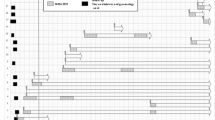Abstract
Background
Antimicrobial resistance may compromise the efficacy of antibiotic prophylaxis before surgery. The aim of this study was to measure susceptibility and clonal distribution of coagulase-negative staphylococci (CoNS) colonizing the skin around the surgery access site before and after the procedure.
Methods
From March to September 2004, a series of 140 patients undergoing elective major abdominal surgery were screened for CoNS colonization at admission and 5 days after surgery. All isolates were tested for antibiotic susceptibility and genotyped by pulsed-field gel electrophoresis (PFGE).
Results
Colonization rates with CoNS at admission and after surgery were 85% and 55%, respectively. The methicillin-resistant CoNS rate increased from 20% at admission to 47% after surgery (P = 0.001). The PFGE pattern after surgery revealed more patients colonized with identical clones: 8/140 patients (8/119 strains) and 26/140 patients (26/77 strains), respectively (P < 0.001).
Conclusions
Our results suggest rapid recolonization of disinfected skin by resistant nosocomial CoNS. Larger studies, preferably among orthopedic or cardiovascular patients, are required to clarify whether standard antibiotic prophylaxis with first- or second-generation cephalosporins for CoNS infections may be compromised if the patient requires an additional intervention 5 days or more after the initial surgery.
Similar content being viewed by others
References
Hidron AI, Edwards JR, Patel J et al (2008) NHSN annual update: antimicrobial-resistant pathogens associated with healthcare-associated infections: annual summary of data reported to the National Healthcare Safety Network at the Centers for Disease Control and Prevention, 2006–2007. Infect Control Hosp Epidemiol 29:996–1011
Jarvis WR, Martone W (1992) Predominant pathogens in hospital infections. J Antimicrob Chemother 29(Suppl):19–24
Mangram AJ, Horan TC, Pearson ML et al (1999) Guideline for prevention of surgical site infection, 1999: Hospital Infection Control Practices Advisory Committee. Infect Control Hosp Epidemiol 20:247–278
Stratchounski LS, Taylor EW, Dellinger EP et al (2005) Antibiotic policies in surgery: a consensus paper. Int J Antimicrob Agents 26:312–322
DiPiro JT, Vallner JJ, Bowden TA et al (1985) Intraoperative serum and tissue activity of cefazolin and cefoxitin. Arch Surg 120:829–832
Anderson DJ, Kaye KS, Classen D et al (2008) Strategies to prevent surgical site infections in acute care hospitals. Infect Control Hosp Epidemiol 29:S51–S61
Wisplinghoff H, Bischoff T, Tallent SM et al (2004) Nosocomial bloodstream infections in US hospitals: analysis of 24, 179 cases from a prospective nationwide surveillance study. Clin Infect Dis 39:309–317
Cuevas O, Cercenado E, Vindel A et al (2004) Evolution of the antimicrobial resistance of Staphylococcus spp. in Spain: five nationwide prevalence studies, 1986 to 2002. Antimicrob Agents Chemother 48:4240–4245
Widerström M, Monsen T, Karlsson C et al (2006) Molecular epidemiology of methicillin-resistant coagulase-negative staphylococci in a Swedish county hospital: evidence of intra- and interhospital clonal spread. J Hosp Infect 64:177–183
Fleisch F, Zbinden R, Vanoli C et al (2001) Epidemic spread of a single clone of methicillin-resistant Staphylococcus aureus among injection drug users in Zurich, Switzerland. Clin Infect Dis 32:581–586
Tenover FC, Arbeit RD, Goering RV et al (1995) Interpreting chromosomal DNA restriction patterns produced by pulsed field gel electrophoresis: criteria for bacterial strain typing. J Clin Microbiol 33:2233–2239
Baum ML, Anish DS, Chalmers TC et al (1981) A survey of clinical trials of antibiotic prophylaxis in colon surgery: evidence against further use of no-treatment controls. N Engl J Med 305:795–799
Meijer WS, Schmitz PI, Jeekel J (1990) Meta-analysis of randomized, controlled clinical trials of antibiotic prophylaxis in biliary tract surgery. Br J Surg 77:283–290
Classen DC, Evans RS, Pestotnik SL et al (1992) The timing of prophylactic administration of antibiotics and the risk of surgical-wound infection. N Engl J Med 326:281–286
Wong ES (2004) Surgical site infections. In: Mayhall CG (ed) Hospital epidemiology and infection control, 3rd edn. Lippincott Williams & Wilkins, Philadelphia
Larson E, McGinley KJ, Grove GL et al (1986) Physiologic, microbiologic, and seasonal effects of handwashing on the skin of health care personnel. Am J Infect Control 14:51–59
Reynolds R, Potz N, Colman M et al (2004) BSAC Extended Working Party on Bacteraemia Resistance Surveillance. Antimicrobial susceptibility of the pathogens of bacteraemia in the UK and Ireland 2001–2002: the BSAC Bacteraemia Resistance Surveillance Programme. J Antimicrob Chemother 53:1018–1032
Karlowsky JA, Jones ME, Draghi DC et al (2004) Prevalence and antimicrobial susceptibilities of bacteria isolated from blood cultures of hospitalized patients in the United States in 2002. Ann Clin Microbiol Antimicrob 3:7–14
Kotilainen P, Nikoskelainen J, Huovinen P (1990) Emergence of ciprofloxacin-resistant coagulase-negative staphylococcal skin flora in immunocompromised patients receiving ciprofloxacin. J Infect Dis 161:41–44
Smith KR, Cobbs CG (1992) In vitro activity of sparfloxacin and three other fluoroquinolones against methicillin-resistant Staphylococcus aureus and Staphylococcus epidermidis. Eur J Clin Microbiol Infect Dis 11:55–58
Acknowledgments
We thank the members of the Clinic of Visceral Surgery and the operating teams of the Department of Surgery of the University Hospital of Zurich for their contribution. The study was supported by an unrestricted research grant from GlaxoSmithKline, Switzerland.
Author information
Authors and Affiliations
Corresponding author
Rights and permissions
About this article
Cite this article
Zingg, W., Demartines, N., Imhof, A. et al. Rapid Colonization with Methicillin-Resistant Coagulase-Negative Staphylococci After Surgery. World J Surg 33, 2058–2062 (2009). https://doi.org/10.1007/s00268-009-0167-3
Published:
Issue Date:
DOI: https://doi.org/10.1007/s00268-009-0167-3




